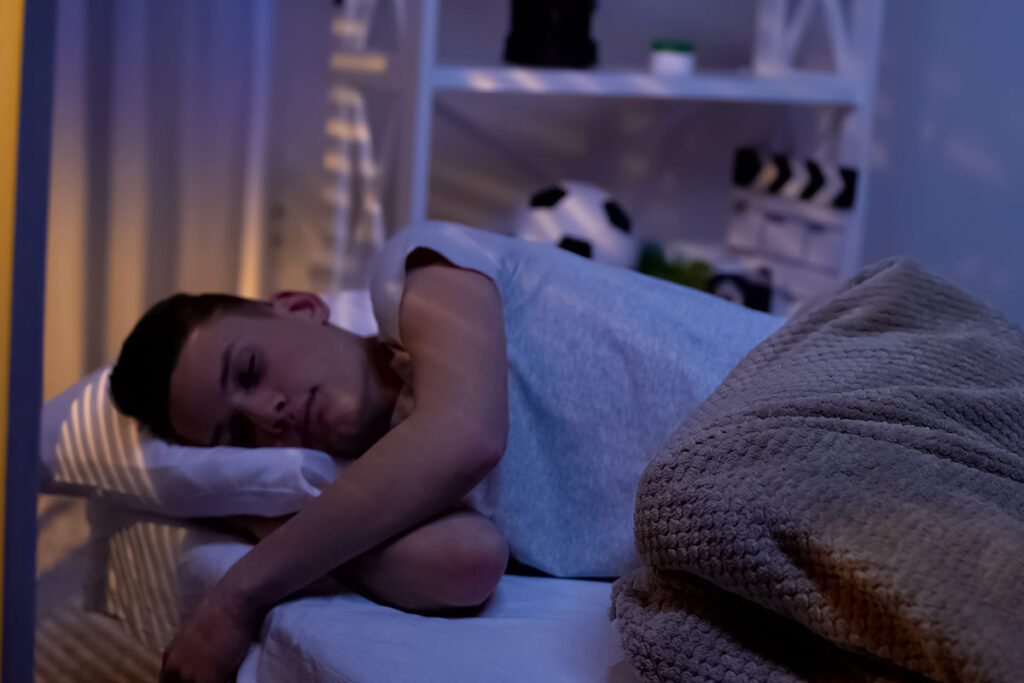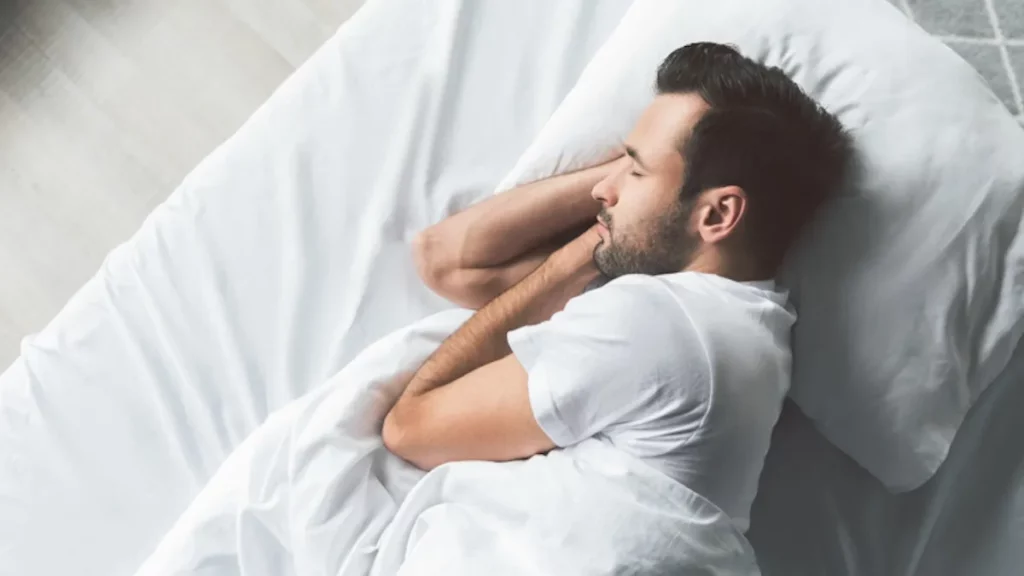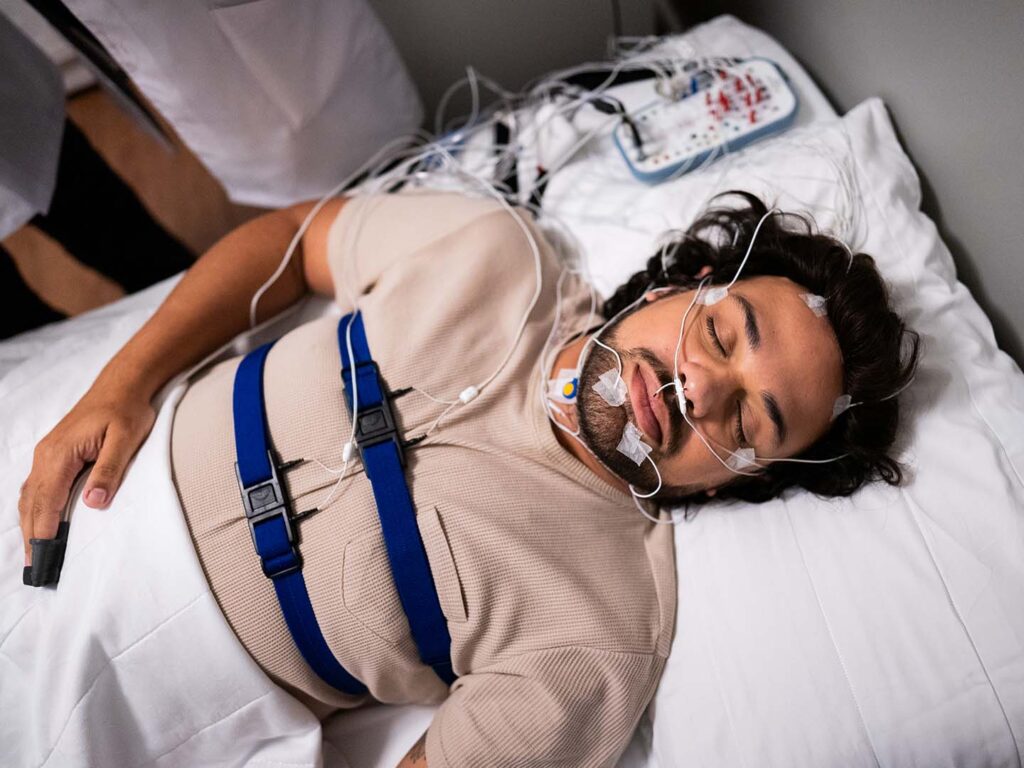What Is a Sleep Study Test and How Does It Work?
A sleep study test is a comprehensive diagnostic procedure designed to evaluate your sleep patterns and identify potential sleep disorders. This non-invasive medical assessment provides healthcare professionals with detailed insights into what happens to your body during sleep, helping them diagnose conditions that may be disrupting your rest and affecting your overall health.
What Is Polysomnography?
Polysomnography serves as the gold standard for sleep monitoring, functioning as a sophisticated diagnostic tool that records multiple physiological processes simultaneously throughout the night. This advanced technology transforms what appears to be a simple night’s sleep into a wealth of medical data that can reveal hidden sleep disorders.
How Does Polysomnography Work?
The polysomnography process utilises an array of sensors strategically placed on your body to capture comprehensive sleep data. These sensors work alongside video and audio monitoring equipment to create a complete picture of your sleep experience. The monitoring system operates silently throughout the night, ensuring your natural sleep patterns remain undisturbed whilst collecting crucial diagnostic information.
What Does Polysomnography Monitor?
During the study, multiple body systems undergo continuous monitoring:
- Brain waves – tracking sleep stages and neurological activity
- Heart activity – monitoring cardiac rhythm and rate variations
- Muscle movements – detecting leg movements and muscle tension
- Breathing patterns – identifying respiratory irregularities
- Oxygen levels – measuring blood oxygen saturation throughout sleep
This comprehensive approach enables sleep specialists to identify various sleep disorders and develop targeted treatment plans tailored to your specific needs.
Where Can a Sleep Study Be Conducted?
You have two primary options when undergoing a sleep study test: an in-lab sleep study at a dedicated sleep center or home-based testing in the comfort of your own bedroom.
In-Lab Sleep Studies
Sleep centers provide comprehensive monitoring with trained technologists supervising your test throughout the night. These facilities offer:
- Complete polysomnography with full sensor arrays
- Real-time monitoring and immediate technical adjustments
- Controlled environment optimised for sleep testing
- Access to specialised equipment for complex sleep disorders
The main limitation involves sleeping in an unfamiliar environment, which may affect your natural sleep patterns and potentially impact test accuracy.
Home Sleep Studies
Home sleep study options allow you to undergo testing in your familiar sleeping environment. Benefits include:
- Natural sleep setting without environmental disruptions
- Greater convenience and reduced costs
- Suitable for suspected obstructive sleep apnea cases
However, home-based testing provides limited monitoring capabilities compared to laboratory studies. You won’t have technical support available during the night, and the equipment typically monitors fewer body systems, making it less suitable for diagnosing complex sleep disorders beyond sleep apnea.
How Should You Prepare for an In-Lab Sleep Study?
Preparing for a sleep study involves specific actions you need to take to ensure the test results are accurate and the sensors are placed correctly. The sleep centre will give you detailed instructions before the test that you must follow closely in the days leading up to your appointment.
Personal Care Guidelines
Hygiene guidelines are crucial for successful sensor attachment. Here’s what you should avoid using:
- Hair products such as gels, sprays, or oils
- Moisturisers or creams on your face, chest, and legs
- Makeup or foundation
- Nail polish (which can interfere with oxygen monitoring)
Make sure to wash your hair with regular shampoo the night before your study, and skip any conditioning treatments that might create a barrier between sensors and your scalp.
Dietary Restrictions
You need to be careful about your caffeine and alcohol consumption before the test. Here’s what you should do:
- Avoid caffeine after 2 PM on the day of your study, as it can significantly impact your ability to fall asleep naturally.
- Eliminate alcohol completely for 24 hours prior to testing, as it alters normal sleep patterns and can affect breathing during sleep.
These preparation steps are important because they ensure the monitoring equipment works properly and accurately captures your usual sleep behaviour.
What Happens During a Sleep Study Test?
When you arrive at the sleep centre for your Sleep Study Test: What It Involves and When You Might Need One, a trained technician will guide you through the sensor attachment process. This typically begins 1-2 hours before your usual bedtime to allow adequate preparation time.
The technician will carefully place multiple sensors on your body using adhesive tape and specialised gel. You’ll have electrodes attached to your scalp to monitor brain waves, sensors near your eyes to track eye movements, and electrodes on your chest to record heart activity. Breathing sensors are positioned around your nose and mouth, while elastic belts wrap around your chest and abdomen to measure respiratory effort. A small clip on your finger monitors oxygen levels throughout the night.
During overnight monitoring, sleep centre staff continuously observe your sleep patterns through video cameras and monitor the data streams from all sensors. The technicians remain awake throughout the night, watching for any technical issues with equipment and ensuring your safety and comfort. They can communicate with you through an intercom system if needed and will wake you in the morning to remove the sensors, completing your patient experience.

What Data Is Collected During a Sleep Study and How Is It Analyzed?
Your sleep study generates comprehensive data across multiple body systems throughout the night. The polysomnography equipment records detailed information about your sleep stages analysis, tracking the progression through different phases of sleep including light sleep (N1), deep sleep (N2), slow-wave sleep (N3), and REM sleep. Each stage reveals distinct brainwave patterns that help specialists understand your sleep architecture.
Breathing patterns receive particular attention during data collection. The sensors monitor:
- Airflow through your nose and mouth
- Chest and abdominal movement
- Blood oxygen saturation levels
- Snoring intensity and frequency
Apnea events detection occurs when the analysis reveals interruptions in breathing lasting ten seconds or longer. These events are categorised as obstructive, central, or mixed apneas, with each type indicating different underlying causes.
Limb movement tracking captures involuntary leg movements, arm movements, and position changes throughout the night. This data helps identify conditions like restless leg syndrome or periodic limb movement disorder.
Sleep technologists and physicians analyse this multi-layered data to create a comprehensive picture of your sleep quality and identify specific disorders requiring treatment.
What Are the Common Conditions Diagnosed Through Sleep Studies?
Sleep studies are powerful tools used to diagnose various sleep disorders that can greatly affect your quality of life. Here are some of the most common conditions diagnosed through sleep studies:
1. Obstructive Sleep Apnea
Obstructive sleep apnea is the most commonly diagnosed condition. It is characterised by repeated breathing interruptions during sleep caused by blockages in the airway. The data collected from the sleep study, known as polysomnography, reveals these apnea events through drops in oxygen levels and disruptions in breathing patterns.
2. Periodic Limb Movement Disorder
Another common finding is periodic limb movement disorder. This condition involves involuntary leg movements during sleep that lead to fragmented sleep. The sensors used in the study detect these repetitive muscle contractions, which often go unnoticed by patients but significantly disrupt the normal structure of sleep.
3. Narcolepsy
The diagnosis of narcolepsy heavily relies on data from sleep studies showing abnormal patterns of REM (rapid eye movement) sleep. These patterns include a quick onset of REM sleep and irregular sleep-wake cycles. The test also captures the characteristic sleep attacks and episodes of cataplexy that define this neurological condition.
4. REM Sleep Behaviour Disorder
REM behaviour disorder is identified through an analysis of muscle activity during REM sleep. In this condition, the usual paralysis of muscles that occurs during REM sleep fails to happen, allowing patients to physically act out their dreams. This can create potentially dangerous situations, which are documented through video monitoring during the study for accurate diagnosis.
When Might Someone Need a Sleep Study Test?
There are several symptoms that indicate the need for a sleep study evaluation that require medical attention and possibly polysomnography testing. You might need a sleep study if you have persistent loud snoring with breathing interruptions during sleep, as these often indicate obstructive sleep apnoea.
Key warning signs include:
- Excessive daytime sleepiness despite adequate sleep duration
- Morning headaches or dry mouth upon waking
- Difficulty concentrating or memory problems
- Restless leg sensations or frequent limb movements during sleep
- Witnessed breathing pauses or gasping episodes
- Insomnia or frequent nighttime awakenings
You should consider sleep study testing if your partner reports disruptive snoring or breathing irregularities. Unexplained fatigue that persists despite lifestyle changes also indicates potential sleep disorders requiring professional evaluation. These sleep disorders can significantly impact your quality of life.
Medical conditions such as high blood pressure, diabetes, or heart disease increase your risk for sleep-related breathing disorders. Your healthcare provider may recommend testing if you have these comorbidities alongside sleep-related symptoms. Age and weight factors also influence sleep study recommendations, particularly for individuals over 40 or those with elevated BMI measurements.
What Are the Risks and Limitations Associated With Sleep Studies?
Sleep studies, like the ones mentioned in this Hopkins Medicine article, have very few risks of polysomnography tests, making them one of the safest diagnostic procedures available. The monitoring equipment used during these tests is completely non-invasive, requiring no injections, medications, or surgical procedures.
Potential Risks and Limitations
Here are some potential risks and limitations associated with sleep studies:
- Physical discomfort: This is the main concern for most patients. The sensors attached to your skin may cause mild irritation or leave temporary marks where adhesive tape was applied.
- Difficulty falling asleep: Some people find it hard to fall asleep in an unfamiliar environment, especially during in-lab studies, which can affect the accuracy of results.
- Skin sensitivity reactions: Occasionally, there may be reactions from the electrode adhesives, but these usually go away within hours of removing the sensors. You might notice slight redness or minor skin irritation at attachment points.
- Sleep disruption: If you sleep significantly less than usual during the study, it can limit the quality of data collected. In such cases, your healthcare provider may recommend repeating the test to ensure a thorough monitoring of your sleep patterns.
- Less comprehensive data: Home sleep studies reduce many limitations by allowing you to sleep in your familiar environment, but they provide less detailed information compared to laboratory-based polysomnography tests which are more comprehensive as discussed in this PMC article.

How Are Sleep Study Results Used to Guide Treatment?
Sleep doctors carefully analyse your polysomnographic data to identify specific sleep disorders and determine the most effective treatment approach. The detailed recordings from your sleep study provide crucial information about breathing patterns, oxygen levels, and sleep structure that directly influence treatment decisions.
CPAP initiation therapy based on results from a patient’s polysomnographic examination represents one of the most common treatment pathways. When your sleep study reveals obstructive sleep apnoea, healthcare providers use the severity index and breathing event patterns to prescribe appropriate CPAP pressure settings and equipment specifications.
Your sleep study results guide various treatment recommendations:
- CPAP therapy for moderate to severe sleep apnoea
- Oral appliances for mild sleep apnoea or CPAP intolerance
- Lifestyle changes including weight management and sleep position training
- Surgical procedures for specific anatomical issues
- Medication adjustments for underlying conditions affecting sleep
Healthcare providers combine your sleep study findings with medical history and symptoms to create personalised treatment plans. The quantitative data from polysomnography ensures treatment recommendations match the severity and type of sleep disorder identified during your overnight monitoring session. You may like to visit https://primecarecebu.com/sleep-apnea-test-perth-early-detection-and-treatment-options/ to get more about Sleep Apnea Test Perth: Early Detection and Treatment Options.
What Support Services Are Available for Patients Undergoing Sleep Studies in Australia?
Air Liquide Healthcare Sleep Solutions is the largest provider of home sleep apnoea studies and therapy in Australia. They offer comprehensive support throughout your diagnostic and treatment journey, ensuring you receive integrated care from initial diagnosis to ongoing therapy management.
The company works with a wide range of sleep brands, including:
- SNORE Australia
- Healthy Sleep Solutions
- Mycroft
- Complete Care
- Sleep Disorder Australia (SDCA)
These partnerships with CPAP equipment manufacturers allow them to offer validated diagnostic services and treatment solutions, all supervised by qualified Sleep Physicians.
Medicare and Insurance Coverage
Medicare coverage applies to diagnostic sleep tests that meet MBS (Medicare Benefits Schedule) guidelines, making essential sleep studies accessible to eligible patients. You should verify your specific eligibility requirements with Medicare before scheduling your test.
Private health insurers may cover CPAP therapy under specific packages, though coverage varies between providers. Contact your insurer directly to understand your entitlements and any waiting periods that may apply.
Air Liquide Healthcare’s home-based programs include non-invasive sleep recording, CPAP therapy initiation, titration programmes, and ongoing therapy guidance. Their regular check-up services ensure your treatment remains effective and comfortable, providing the support you need to manage your sleep disorder successfully from the comfort of your own home.

